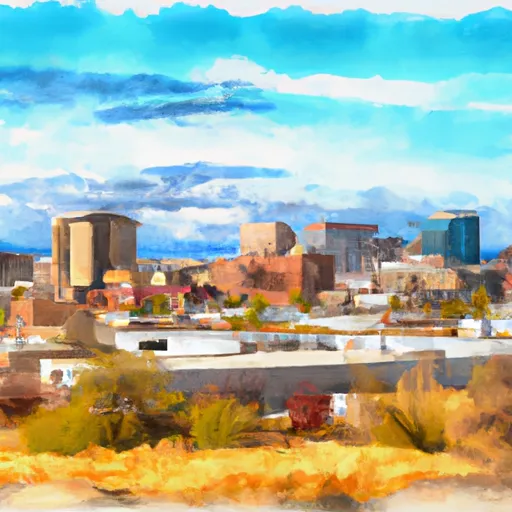-
 Snoflo Premium
Snoflo Premium
Get unlimited access to all our content
With no Ad interruptions! - Start Your Free Trial Login with existing account
Richland
Eden Index
Climate
7.0
•
Recreation
5.2
•
Community
3.3
•
Safeguard
5.4/10

Richland, Washington is a vibrant city located in the southeastern part of the state. It experiences a semi-arid climate, characterized by hot summers and cool winters. Summers can be quite hot, with temperatures often exceeding 90°F (32°C). Winters are mild, with average temperatures hovering around freezing. The region receives minimal precipitation, averaging around 7 inches (18 cm) annually.
The city is situated along the Columbia River, which plays a significant role in its hydrology. The river serves as a vital water source and supports various recreational activities such as boating, fishing, and kayaking. Additionally, Richland is surrounded by several natural reservoirs and wetlands, providing ample opportunities for birdwatching and wildlife observation.
Outdoor enthusiasts can explore the numerous parks and trails in and around Richland. Badger Mountain Centennial Preserve offers hiking trails with stunning views of the city and surrounding landscape. The nearby Yakima River Delta offers opportunities for hiking, camping, birding, and picnicking. Columbia Park, located along the river, provides extensive recreational facilities, including playgrounds, sports fields, and a boat launch.
Overall, Richland's unique climate, hydrology constituents, and diverse outdoor recreation opportunities make it an appealing destination for those who enjoy outdoor activities and the beauty of nature.
What is the Eden Index?
The Snoflo Eden Index serves as a comprehensive rating system for regions, evaluating their desirability through a holistic assessment of climate health, outdoor recreation opportunities, and natural disaster risk, acknowledging the profound impact of these factors on livability and well-being.
Climate Health Indicator (CHI): 7.0
Richland receives approximately
196mm of rain per year,
with humidity levels near 84%
and air temperatures averaging around
12°C.
Richland has a plant hardyness factor of
7, meaning
plants and agriculture in this region tend to thrive during the non-winter months.
By considering the ideal temperature range, reliable water supplies, clean air, and stable seasonal rain or snowpacks, the Climate Health Indicator (CHI) underscores the significance of a healthy climate as the foundation for quality living.
A healthy climate is paramount for ensuring a high quality of life and livability in a region, fostering both physical well-being and environmental harmony. This can be characterized by ideal temperatures, reliable access to water supplies, clean air, and consistent seasonal rain or snowpacks.
Weather Forecast
Streamflow Conditions
Upper Columbia
Area Rivers
Upper Columbia
Snowpack Depths
Upper Columbia
Reservoir Storage Capacity
Upper Columbia
Groundwater Levels
Recreational Opportunity Index (ROI): 5.2
The Recreational Opportunity Index (ROI) recognizes the value of outdoor recreational options, such as parks, hiking trails, camping sites, and fishing spots, while acknowledging that climate plays a pivotal role in ensuring the comfort and consistency of these experiences.
Access to outdoor recreational opportunities, encompassing activities such as parks, hiking, camping, and fishing, is crucial for overall well-being, and the climate plays a pivotal role in enabling and enhancing these experiences, ensuring that individuals can engage in nature-based activities comfortably and consistently.
Camping Areas
| Campground | Campsites | Reservations | Toilets | Showers | Elevation |
|---|---|---|---|---|---|
| Horn Rapids County Park | None | 426 ft | |||
| Ringold Springs - WDFW | None | 400 ft | |||
| Columbia Park | None | 355 ft | |||
| Sand Station | 20 | 355 ft | |||
| Umatilla Marina RV Park | None | 300 ft | |||
| Plymouth Park | None | 294 ft |
Nearby Ski Areas
Catastrophe Safeguard Index (CSI):
The Catastrophe Safeguard Index (CSI) recognizes that natural disaster risk, encompassing floods, fires, hurricanes, and tornadoes, can drastically affect safety and the overall appeal of an area.
The level of natural disaster risk in a region significantly affects safety and the overall livability, with climate change amplifying these risks by potentially increasing the frequency and intensity of events like floods, fires, hurricanes, and tornadoes, thereby posing substantial challenges to community resilience and well-being.
Community Resilience Indicator (CRI): 3.3
The Community Resilience Indicator (CRI) recognizes that education, healthcare, and socioeconomics are crucial to the well-being of a region. The CRI acknowledges the profound impact of these elements on residents' overall quality of life. By evaluating educational resources, healthcare accessibility, and economic inclusivity, the index captures the essential aspects that contribute to a thriving community, fostering resident satisfaction, equity, and social cohesion.

